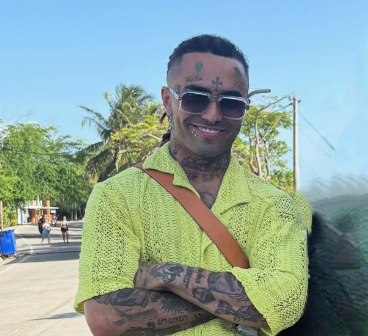Lil Pump’s financial ascent to a net worth of about $12 million is a striking example of how contemporary artists use digital platforms to turn viral attention into bankable fame. Lil Pump, whose real name is Gazzy Garcia, did not climb the traditional music industry ladders. Instead, his unapologetic brash performances, memorable hooks, and wild visuals captured the chaos of youth culture and looped it, causing him to explode onto the scene.

A generation of Gen Z rappers has been able to circumvent traditional gatekeeping over the past ten years thanks to platforms like SoundCloud and TikTok. Lil Pump skillfully used this model by posting songs that resonated with teenagers who were experiencing similar levels of energy, angst, and attention deficit. “Gucci Gang,” his 2017 hit, became a cultural landmark. Even though it was just a few words sung over a mesmerizing beat, it had a huge impact, becoming quintuple platinum and putting Lil Pump in the top tier of streamers.
Lil Pump Biography and Career Overview
| Category | Details |
|---|---|
| Full Name | Gazzy Fabio Garcia |
| Stage Name | Lil Pump |
| Date of Birth | August 17, 2000 |
| Age | 24 |
| Birthplace | Miami, Florida, USA |
| Known For | “Gucci Gang,” SoundCloud Rap Movement |
| Occupation | Rapper, Songwriter |
| Active Since | 2015 |
| Record Labels | Tha Lights Global, Warner |
| Signature Tracks | “Gucci Gang,” “I Love It,” “Esskeetit,” “Drug Addicts” |
| Collaborations | Kanye West, Lil Wayne, Diplo, French Montana, Adele Givens |
| Estimated Net Worth | $12 million (as of 2025) |
| Legal Controversies | Firearm discharge, drug cases, travel bans |
| Health Challenges | Dyslexia |
| Personal Loss | Father Fabio Garcia passed away in April 2022 |
| Reference Website |
Working with Kanye West on “I Love It” gave him access to a new level of visibility in addition to securing a hit. Despite causing controversy, Kanye’s artistic influence cannot be denied. Their collaboration demonstrated how satire and commercial viability could coexist in a meme-worthy song. Introduced at the Pornhub Awards and supported by an odd, blocky video that practically pleaded to be shared, the release was timed to have a viral impact.
Pump was incredibly flexible in adjusting to social media trends, creating an audience that was more interested in a common identity amid chaos than in lyrical content. This strategy, which is based on aesthetic rebellion, catchy minimalism, and a rebellious persona, proved especially helpful in a time when scrolling rather than radio is the primary method of discovering new music.
His income is distributed among sponsorship agreements, merchandise drops, streaming services, and touring. Some artists make a lot of money from legacy album sales, but Pump’s model yields much faster results. His capsules of merchandise frequently sell out in a matter of minutes. Even though they can be chaotic and contentious, concerts continue to attract devoted audiences. Even though most people were grounded during the pandemic, his digital footprint kept making money—proof that attention can still be profitable once it is captured.
He has experienced setbacks despite his success. There are lessons to be learned from Lil Pump’s journey regarding financial discipline. What happens when fame surpasses financial literacy was made clear by the IRS lien in 2021, which referenced $1.6 million in unpaid taxes. Other quickly rising artists who misjudge their own development suffer the same fate. Even well-known performers, like Lauryn Hill and Tyga, have encountered comparable tax problems, indicating that effective management frequently lags behind sudden success.
Through calculated partnerships, Lil Pump became a brand as well as an artist, breaking into the hip-hop elite. His discography gained a commercial sheen thanks to songs like “Be Like Me,” which featured Lil Wayne, and “Butterfly Doors,” which featured Diplo. However, what really demonstrates his financial tenacity is his ability to consistently resurface, even following media exhaustion or legal troubles. The reputations of other artists might have been severely damaged by their arrests for disorderly conduct in Miami and Copenhagen, as well as their temporary ban from JetBlue for refusing to wear a mask. They oddly enhanced Pump’s reputation as an unrefined performer.
He follows in the footsteps of artists who have made money off of notoriety, such as Blueface and 6ix9ine, by embracing controversy rather than running away from it. Despite the risk, this rebellious marketing has been surprisingly cost-effective in terms of financial consequences and incredibly effective at capturing and retaining digital attention. His team appears to be aware that maintaining media attention—even for the wrong reasons—often results in increases in streaming metrics.
The way Pump has transformed personal struggles into relatable stories is especially inventive. He counterbalanced his exaggerated stage persona by revealing a more human side by talking about his dyslexia. Supporters, particularly younger ones dealing with their own academic challenges, reacted favorably. It added depth to his image, implying that a young man navigating fame without a script was hiding behind the brilliant hair and diamond grills.
It will be interesting to watch how he changes over the next few years. He may be able to draw in new fans while retaining his core following if he starts incorporating more mature themes and leans into his vulnerabilities. Similar shifts from youthful chaos to artistic introspection have been accomplished by artists such as Tyler, The Creator, and Post Malone. Pump may never be hip-hop’s poet laureate, but that isn’t the aim. His ability to draw in audiences and keep them coming back for more is what gives him financial value.
The rapper has shown indications of reinvention since the release of Lil Pump 2. The album had more structure and sonic diversity, according to critics who had previously completely disregarded his discography. Even though it didn’t chart as well as earlier releases, it was a necessary turnabout that showed the industry and fans alike that growth is possible, even if it’s messy and slow.
There is more to Lil Pump’s $12 million net worth than just Spotify subscriptions and YouTube views when viewed through the prism of modern music culture. It represents the transition to decentralized stardom. Traditional talent scouts and large budgets are no longer necessary for success. Despite being unconventional, Pump’s success demonstrated that raw energy can be used to produce a very dependable financial model.
He established a model for future musicians by fusing digital-first tactics, meme culture, and merchandise acumen. The way the industry finds new talent has significantly improved as a result of his influence. More money is now being spent by labels on viral potential rather than well-executed demos. Lil Pump’s legacy, whether it is praised or criticized, will therefore have an impact on the upcoming generation of artists hoping to earn millions from their bedrooms.
